Here we have listed some of the most frequently asked questions that have been asked of us over the phone and through email. We hope this will help answer any questions you may have. If your question is not answered here, please send us an email or give us a call and we will be happy to help you.
-
My ball python stopped eating or will not eat. What should I do?
-
Could you send me detailed breeding information?
-
My snake escaped. Help!
-
Where are you located? We would like to come see your snakes?
-
What do you have available right now?
-
How can I tell if my snake is a male or female?
-
My snake has a retained eye cap and/or my snake is shedding in pieces. What should I do?
-
At what age can I breed my Ball Python?
-
My snake opens its' mouth alot. Is there a problem?
-
What does CB, CH, and WC mean?
-
What does 1.0 mean?
-
AHHHH my snake has mites/ticks! What should I do?
-
The mouse/rat just bit my snake. What should I do?
-
Could you send me detailed information on how to take care of my snake?
-
I just found eggs in my snakes cage! What should I do?
-
How do you ship snakes?
-
My ball python stopped eating or will not eat. What should I do?
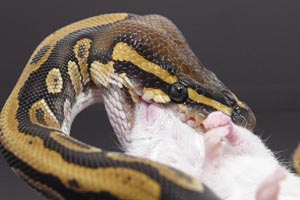 There can be many reasons why ball pythons will not eat. We will try to address some of them here. Newly
purchased import adult or baby ball pythons may not eat. If your ball pyhton was recently purchased from a pet store, chances are great
that it is an imported animal and it may not have eaten since it has been in captivity. Leave the snake alone and make sure the cage is
set up properly. Try offering an appropriate sized rat or mouse to the snake in the evening. Many ball pythons prefer to eat at night.
You may also need to try gerbils or hamsters. DO NOT LEAVE A LIVE RODENT IN THE CAGE WITH THE SNAKE FOR MORE THAN 15 MINUTES. A cornered
rodent can and will inflict serious damage to your snake. The important issue here is to get the snake to feed. Once that is accomplished
and the snake is feeding on a regular basis, than you can work on switching the snake over to dead food. Hatchling ball pythons can not go
with out food for as long as the adults can. By the time you get the snake it may not have eaten since it hatched. If the snake does not
eat for you within a short period of time you may need to have the snake force fed by your local vet. We always recommend that you watch
the snake eat at the pet store BEFORE you buy and bring the snake home. Many ball pythons that have been eating regularly will stop
feeding in the winter and will most likely not begin feeding again until late Spring. Although nerve racking to the owner, this is typical
ball python behavior. Unless your snake is younger than one year of age or under weight, this fast should not pose any problems for your
snake. Consult your local veterinarian if you think that your snakes' fast has been too long or your snake appears to be losing weight.
Not all ball pythons will fast during the winter.
There can be many reasons why ball pythons will not eat. We will try to address some of them here. Newly
purchased import adult or baby ball pythons may not eat. If your ball pyhton was recently purchased from a pet store, chances are great
that it is an imported animal and it may not have eaten since it has been in captivity. Leave the snake alone and make sure the cage is
set up properly. Try offering an appropriate sized rat or mouse to the snake in the evening. Many ball pythons prefer to eat at night.
You may also need to try gerbils or hamsters. DO NOT LEAVE A LIVE RODENT IN THE CAGE WITH THE SNAKE FOR MORE THAN 15 MINUTES. A cornered
rodent can and will inflict serious damage to your snake. The important issue here is to get the snake to feed. Once that is accomplished
and the snake is feeding on a regular basis, than you can work on switching the snake over to dead food. Hatchling ball pythons can not go
with out food for as long as the adults can. By the time you get the snake it may not have eaten since it hatched. If the snake does not
eat for you within a short period of time you may need to have the snake force fed by your local vet. We always recommend that you watch
the snake eat at the pet store BEFORE you buy and bring the snake home. Many ball pythons that have been eating regularly will stop
feeding in the winter and will most likely not begin feeding again until late Spring. Although nerve racking to the owner, this is typical
ball python behavior. Unless your snake is younger than one year of age or under weight, this fast should not pose any problems for your
snake. Consult your local veterinarian if you think that your snakes' fast has been too long or your snake appears to be losing weight.
Not all ball pythons will fast during the winter.
-
Please send me detailed breeding information.
We feel that it is better to have a book or video, than a few sheets of paper that could easily get lost, therefore we recommend that you purchase Dr. Mark Seward's Ball Python Breeding by Dr. Mark Seward with Colette and Dan Sutherland and The Ball Python Manual published by Advanced Vivarium Systems. These works are put together by people that have actually kept and worked with ball pythons. If you need something that is more technical we suggest The Reproductive Husbandry of Pythons and Boas by Ross and Marzec.
-
My snake escaped. Help!
Like all snakes, ball pythons are escape artists and they will take advantage of any enclosure that is not secure. Many ball pythons are found within a fifteen foot area around the cage. Ball pythons can squeeze into very small areas, so check everywhere.
-
Where are you located? We would like to come see your snakes?
We do not have a retail location and we are not open to the general public. Exceptions are rare. Please visit Our Facility page to get a behind the scenes look at The Snake Keeper!
-
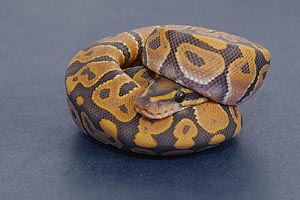
What do you have available right now?
We try to keep snakes that are available for sale on the Currently Available page of our web site. This page includes a photo and a brief history of each available snake. We also accept deposits for snakes that we anticipate producing.
-
How can I tell if my snake is a male or female?
The best way to determine if your python is a male or female is to have it probed. Usually your local veterinarian can probe your snake. There may be a fee for this service. You can also check with your local herp club and ask if anyone there has experience probing snakes and if they do, would they be willing to probe your snake. Relying solely on spur size is not accurate.
-
My snake has a retained eye cap and/or my snake is shedding in pieces.
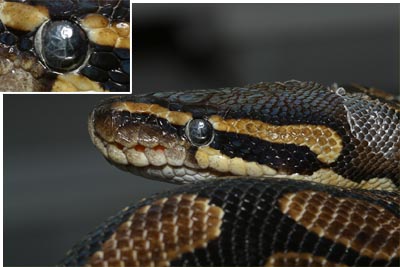 Often in our attempts to keep our ball pythons warm we dry them out. Bad sheds and retained eye caps
are most commonly caused by low humidity. Eye caps can be easily removed with a piece of scotch tape. ONLY DO THIS IF YOU ARE SURE THE
EYE CAP IS STILL ON THE EYE! There are times when it can look like there is a retained eye cap, but there is not. The piece of tape is
applied to a side of the eye and it is used to "catch" the retained eye cap. Generally they will "pop" right off with the tape. If your
snake has numerous eye caps that are stuck, you may need to have them removed by a vet. Retained shed can be removed by soaking the snake
in water for a few minutes and then gentle rub the bad shed skin off. For really stubborn patches of skin you may need to soak the snake
longer. A note of caution - keep an eye on the snake while it is soaking. You do not wish for the snake to escape, or drown.
Often in our attempts to keep our ball pythons warm we dry them out. Bad sheds and retained eye caps
are most commonly caused by low humidity. Eye caps can be easily removed with a piece of scotch tape. ONLY DO THIS IF YOU ARE SURE THE
EYE CAP IS STILL ON THE EYE! There are times when it can look like there is a retained eye cap, but there is not. The piece of tape is
applied to a side of the eye and it is used to "catch" the retained eye cap. Generally they will "pop" right off with the tape. If your
snake has numerous eye caps that are stuck, you may need to have them removed by a vet. Retained shed can be removed by soaking the snake
in water for a few minutes and then gentle rub the bad shed skin off. For really stubborn patches of skin you may need to soak the snake
longer. A note of caution - keep an eye on the snake while it is soaking. You do not wish for the snake to escape, or drown.
-
At what age can I breed my Ball Python?
We go by weight for females and males. We use 1,500 grams as a minimum weight requirement for females. It can take 2 to 3 years to reach this minimum weight, depending upon the amount of food she eats and how regularly she eats. We have found that males tend to be better breeders when they weigh at least 800 grams and are a minimum of 1 1/2 to 2 years old.
-
My snake opens its' mouth alot. Is there a problem?
This really depends upon when the snake is opening its' mouth. If it is doing this right after a meal, the snake is only realigning its' jaws. If your snake appears to be "gasping" for air and is opening its' mouth often and you occasionally hear gurgling or wheezing sounds, it is time for a trip to the vet. It is possible that your snake has a respiratory infection and it will need to be treated with antibiotics.
-
What does CB, CH, and WC mean?
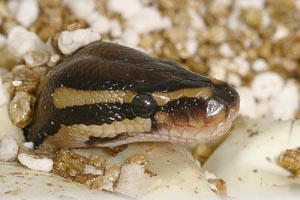 These are abbreviations for the following:
These are abbreviations for the following:
CB = Captive Bred - Two adults in captivity are bred together and they produce a clutch of eggs that hatch.
CB = Captive Born - Same as Captive Hatched, see below.
CH = Captive Hatched - These make up the majority of the ball pythons in the pet trade. Eggs are collected from the wild and placed in large "bins" where they are kept until they hatch. When the eggs begin hatching, the hatchlings are collected and shipped by the thousands to the US importers. The hatchlings will most likely change hands several times before reaching the pet store. Some of these will survive, but many do not.
WC = Wild Caught - Snakes that are collected from the wild and shipped to the US importers. Often the majority of these snakes perish due to their reluctance to eat.
-
What does 1.0 mean?
This is the how the gender of a single snake or a group of snakes is listed. Example: 1.0 would indicate one male and no females. Sometimes you will see a third position 1.1.1; this would indicate one male, one female and one unknown.
-
AHHHH my snake has mites/ticks!
There are many products on the market today that can be used to effectively rid your snake of these common pests. A product called Provent-a-mite that is made by Pro-Products is reported to be extremely effective at exterminating mites and ticks. Make sure you follow the instructions to the letter when using this or any other product to rid your snake of mites and ticks.
-
The mouse/rat just bit my snake. What should I do?
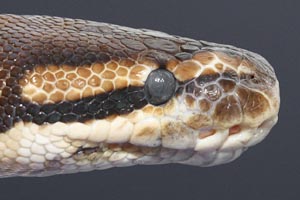 All rodent bites need to be taken seriously. There is always a good chance for them to become
infected. In severe cases, these usually occur when a live rodent has been left in the cage for an extended period of time, the snake may
need to be euthanized. We suggest that you take your snake to the vet as soon as possible if it gets bitten or chewed on by a rodent.
All rodent bites need to be taken seriously. There is always a good chance for them to become
infected. In severe cases, these usually occur when a live rodent has been left in the cage for an extended period of time, the snake may
need to be euthanized. We suggest that you take your snake to the vet as soon as possible if it gets bitten or chewed on by a rodent.
-
Please send me detailed information on how to take care of my snake.
Our best recommendation is to purchase "The Ball Python Manual" published by Advanced Vivarium Systems. This book contains valuable information for anyone and everyone interested in ball pythons and we feel that it is a must have book for anyone interested in ball pythons. This book is also written by people that have actually had experience with ball pythons, making this in our opinion one of the best books on the market for ball pythons.
-
I just found eggs in my snakes cage! What should I do?
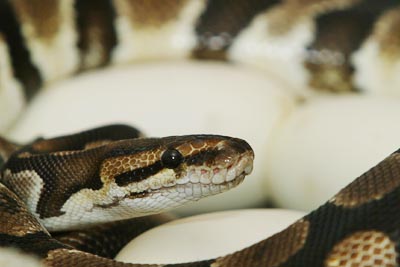 When a pair of snakes is housed together this may eventually happen. However, not being prepared for
the event of eggs can change a time of great excitement into a time of stress. Ball pythons lay fairly large eggs. They are generally
larger than chicken eggs. Fertile eggs will contain veins when candled and will also be white in color similar to a chickens egg.
Non-fertile eggs are referred to as slugs and they will be yellow in color and smaller in size. If you choose to let the snake incubate
her own eggs we suggest removing the male from the cage if you have not already done so. Providing the eggs with the proper humidity and
temperature will be your greatest challenge. We artificially incubate all of our eggs. Please see our Eggs and Incubation
section for a more detailed explanation on how to incubate eggs.
When a pair of snakes is housed together this may eventually happen. However, not being prepared for
the event of eggs can change a time of great excitement into a time of stress. Ball pythons lay fairly large eggs. They are generally
larger than chicken eggs. Fertile eggs will contain veins when candled and will also be white in color similar to a chickens egg.
Non-fertile eggs are referred to as slugs and they will be yellow in color and smaller in size. If you choose to let the snake incubate
her own eggs we suggest removing the male from the cage if you have not already done so. Providing the eggs with the proper humidity and
temperature will be your greatest challenge. We artificially incubate all of our eggs. Please see our Eggs and Incubation
section for a more detailed explanation on how to incubate eggs.
-
How do you ship snakes?
Most snakes are shipped air freight collect by a major air carrier. Occasionally snakes can be shipped UPS to your door under the following conditions; you request this form of shipment and weather conditions are appropriate. The snake is placed in a cloth bag or plastic container with air holes. After being secured in a bag or container the snake is then placed in a Styrofoam lined cardboard box. Newspaper is placed around the snake to help prevent the animal from being bounced around. We use heat packs when weather conditions require their use. During extremely hot or cold periods shipping by major carriers may be suspended. When this occurs the snakes will be held here and feed on a regular basis until weather conditions improve and shipping can resume.
Track Your Shipment
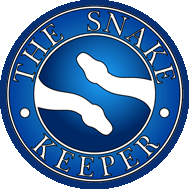


 netviper digital studio
netviper digital studio